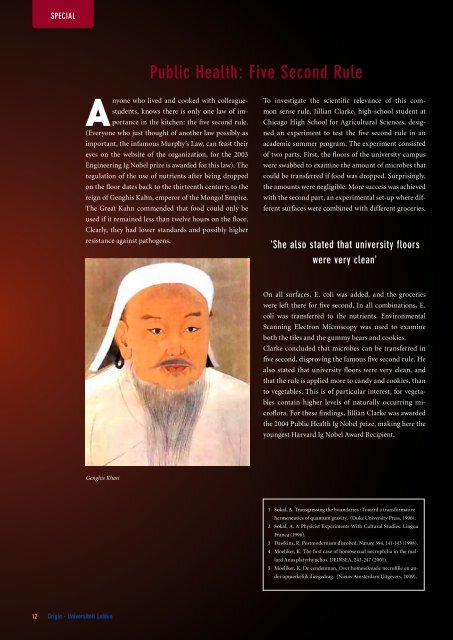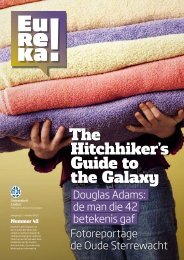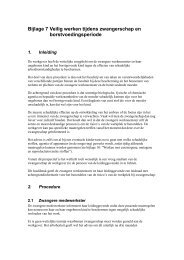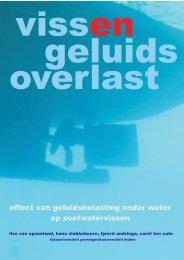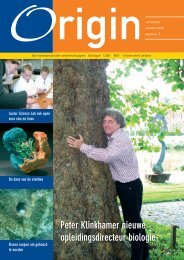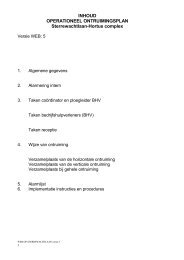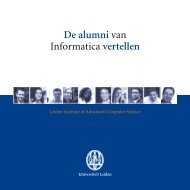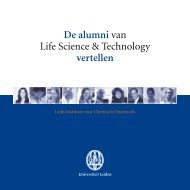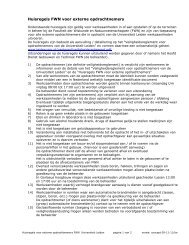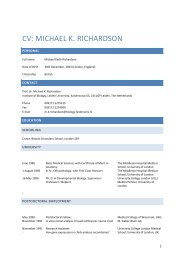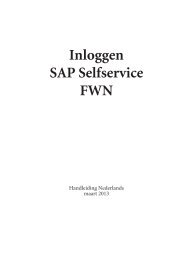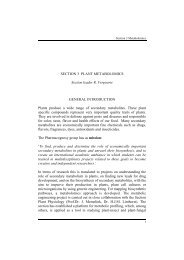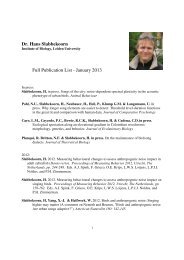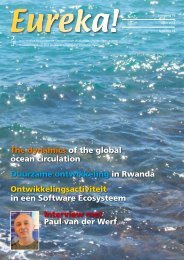nummer 2, januari 2012 - Faculteit der Wiskunde en ...
nummer 2, januari 2012 - Faculteit der Wiskunde en ...
nummer 2, januari 2012 - Faculteit der Wiskunde en ...
Create successful ePaper yourself
Turn your PDF publications into a flip-book with our unique Google optimized e-Paper software.
SPECIAL<br />
Public Health: Five Second Rule<br />
Anyone who lived and cooked with colleaguestud<strong>en</strong>ts,<br />
knows there is only one law of importance<br />
in the kitch<strong>en</strong>: the five second rule.<br />
(Everyone who just thought of another law possibly as<br />
important, the infamous Murphy’s Law, can feast their<br />
eyes on the website of the organization, for the 2003<br />
Engineering Ig Nobel prize is awarded for this law). The<br />
regulation of the use of nutri<strong>en</strong>ts after being dropped<br />
on the floor dates back to the thirte<strong>en</strong>th c<strong>en</strong>tury, to the<br />
reign of G<strong>en</strong>ghis Kahn, emperor of the Mongol Empire.<br />
The Great Kahn comm<strong>en</strong>ded that food could only be<br />
used if it remained less than twelve hours on the floor.<br />
Clearly, they had lower standards and possibly higher<br />
resistance against pathog<strong>en</strong>s.<br />
To investigate the sci<strong>en</strong>tific relevance of this common<br />
s<strong>en</strong>se rule, Jillian Clarke, high-school stud<strong>en</strong>t at<br />
Chicago High School for Agricultural Sci<strong>en</strong>ces, designed<br />
an experim<strong>en</strong>t to test the five second rule in an<br />
academic summer program. The experim<strong>en</strong>t consisted<br />
of two parts. First, the floors of the university campus<br />
were swabbed to examine the amount of microbes that<br />
could be transferred if food was dropped. Surprisingly,<br />
the amounts were negligible. More success was achieved<br />
with the second part, an experim<strong>en</strong>tal set-up where differ<strong>en</strong>t<br />
surfaces were combined with differ<strong>en</strong>t groceries.<br />
'She also stated that university floors<br />
were very clean'<br />
On all surfaces, E. coli was added, and the groceries<br />
were left there for five second. In all combinations, E.<br />
coli was transferred to the nutri<strong>en</strong>ts. Environm<strong>en</strong>tal<br />
Scanning Electron Microscopy was used to examine<br />
both the tiles and the gummy bears and cookies.<br />
Clarke concluded that microbes can be transferred in<br />
five second, disproving the famous five second rule. He<br />
also stated that university floors were very clean, and<br />
that the rule is applied more to candy and cookies, than<br />
to vegetables. This is of particular interest, for vegetables<br />
contain higher levels of naturally occurring microflora.<br />
For these findings, Jillian Clarke was awarded<br />
the 2004 Public Health Ig Nobel prize, making here the<br />
youngest Harvard Ig Nobel Award Recipi<strong>en</strong>t.<br />
G<strong>en</strong>ghis Khan<br />
1 Sokal, A. Transgressing the boundaries : Toward a transformative<br />
herm<strong>en</strong>eutics of quantum gravity. (Duke University Press, 1996).<br />
2 Sokal, A. A Physicist Experim<strong>en</strong>ts With Cultural Studies. Lingua<br />
Franca (1996).<br />
3 Dawkins, R. Postmo<strong>der</strong>nism disrobed. Nature 394, 141-143 (1998).<br />
4 Moeliker, K. The first case of homosexual necrophilia in the mallard<br />
Anas platyrhynchos. DEINSEA, 243-247 (2001).<br />
5 Moeliker, K. De e<strong>en</strong>d<strong>en</strong>man, Over homeseksuele necrofilie <strong>en</strong> an<strong>der</strong><br />
opmerkelijk diergedrag. (Nieuw Amsterdam Uitgevers, 2009).<br />
12<br />
Origin - Universiteit Leid<strong>en</strong>


